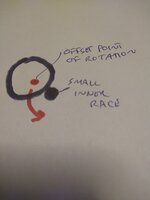- Dec 24, 2014
- 9,177
- 47,401
- Funster No
- 34,553
- MH
- Compass Navigator
- Exp
- Ever since lighting was by Calor gas.
For years I've always considered ball and roller bearings to be near the peak of mechanical bearing efficiency.
However, it has occurred to me that since the diameter of the inner race is smaller than the diameter of the outer race and one of them is always fixed i.e. only one of the races rotates, the balls or rollers must have to skid during their rotation in order to cover the different surface distances over which they have to travel. Maybe they do skid but that seems to be a very disappointing/inefficient feature.
Here's a simplistic graphic of a ball bearing which may help visualise my confusing assumption:

However, it has occurred to me that since the diameter of the inner race is smaller than the diameter of the outer race and one of them is always fixed i.e. only one of the races rotates, the balls or rollers must have to skid during their rotation in order to cover the different surface distances over which they have to travel. Maybe they do skid but that seems to be a very disappointing/inefficient feature.
Here's a simplistic graphic of a ball bearing which may help visualise my confusing assumption:

